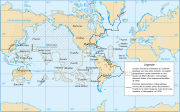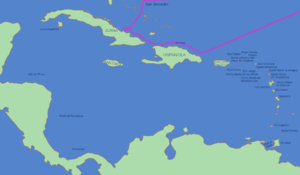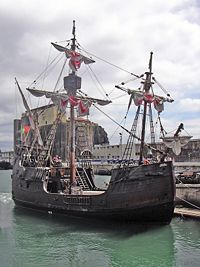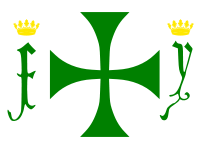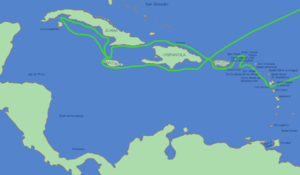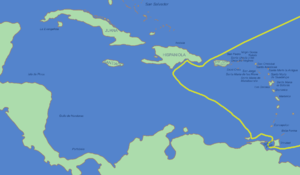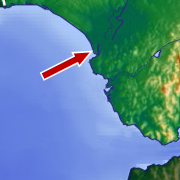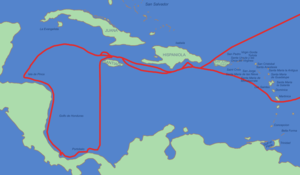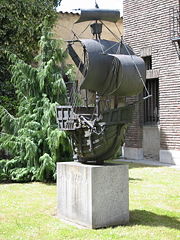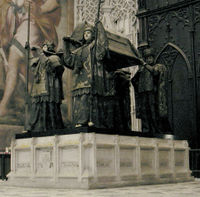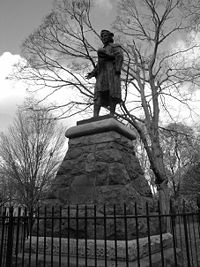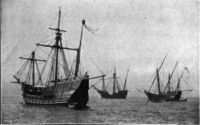Christopher Columbus
2008/9 Schools Wikipedia Selection. Related subjects: Geographers and explorers
| Christopher Columbus | |
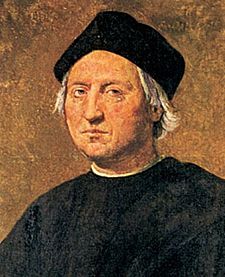 Posthumous portrait of Christopher Columbus by Ridolfo Ghirlandaio.
|
|
| Born | August 25- October 31, 1451 |
|---|---|
| Died | May 20, 1506 outside Valladolid, Spain |
| Nationality | Genovese |
| Other names | Cristoforo Colombo Cristóbal Colón |
| Title | Admiral of the Ocean Sea; Viceroy and Governor of the Indies |
| Religious beliefs | Roman Catholic |
| Spouse(s) | Filipa Moniz (c. 1476-1485) |
| Children | Diego Fernando |
| Relatives | Bartolomeo (brother) Diego (brother) |
Christopher Columbus (born between August 25 and October 31, 1451 – May 20, 1506) was an Italian navigator, colonizer and explorer whose voyages across the Atlantic Ocean led to general European awareness of the Western Hemisphere and of the American continents. Though not the first to reach the Americas from Afro-Eurasia — preceded some five hundred years by Leif Ericson, and perhaps by others — Columbus initiated widespread contact between Europeans and indigenous Americans. With his several hapless attempts at establishing a settlement on the island of Hispaniola, he personally initiated the process of Spanish colonization which foreshadowed general European colonization of the " New World." (The term " pre-Columbian" is sometimes used to refer to the peoples and cultures of the Americas before the arrival of Columbus and his European successors.)
His initial 1492 voyage came at a critical time of growing national imperialism and economic competition between developing nation states seeking wealth from the establishment of trade routes and colonies. In this sociopolitical climate, Columbus's far-fetched scheme won the attention of Queen Isabella of Spain. Severely underestimating the circumference of the Earth, he hypothesized that a westward route from Iberia to the Indies would be shorter and more direct than the overland trade route through Arabia. If true, this would ensure for Spain control of the lucrative spice trade — heretofore commanded by the Arabs and Italians. Following his plotted course, he instead landed within the Bahamas Archipelago at a locale he named San Salvador. Mistaking the North-American island for the East-Asian mainland, he referred to its inhabitants as "Indians".
Academic consensus is that Columbus was born in Genoa, though other minor theories try to challenge it. The name Christopher Columbus is the Anglicization of the Latin Christophorus Columbus. The name is rendered in modern Italian as Cristoforo Colombo, in Portuguese as Cristóvão Colombo (formerly Christovam Colom), and in Spanish as Cristóbal Colón.
The anniversary of Columbus' 1492 landing in the Americas ( Columbus Day) is observed throughout the Americas and in Spain on October 12.
Early life
According to general assumption, nevertheless disputed, Christopher Columbus was born between August and October 1451 in Genoa (nowadays part of Italy). His father was Domenico Colombo, a middle-class wool weaver - who later also had a cheese stand where his son was a helper - working between Genoa and Savona. His mother was Susanna Fontanarossa. Bartolomeo, Giovanni Pellegrino and Giacomo were his brothers. Bartolomeo worked in a cartography workshop in Lisbon for at least part of his adulthood.
While information about Columbus' early years is scarce, he probably received an incomplete education. He spoke a Genoese dialect. In one of his writings, Columbus claims to have gone to the sea at the age of 10. In 1470 the Columbus Family moved to Savona, where Domenico took over a tavern. In the same year, Columbus was on a Genoese ship hired in the service of René I of Anjou to support his attempt to conquer the Kingdom of Naples.
In 1473 Columbus began his apprenticeship as business agent for the important Centurione, Di Negro and Spinola families of Genoa. Later he allegedly made a trip to Chios, a Genoese colony in the Aegean Sea. In May 1476, he took part in an armed convoy sent by Genoa to carry a valuable cargo to northern Europe. He docked in Bristol, Galway, in Ireland and was possibly in Iceland in 1477. In 1479 Columbus reached his brother Bartolomeo in Lisbon, keeping on trading for the Centurione family. He married Filipa Moniz Perestrello, daughter of the Porto Santo governor, the Portuguese nobleman of Genoese origin Bartolomeu Perestrello. In 1479 or 1480, his son, Diego, was born. He calls himself Diego Colon Moniz, and never used Perestrello in his name.
Voyages
Navigation plans
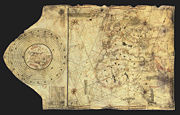
Europe had long enjoyed a safe land passage to China and India— sources of valued goods such as silk, spices, and opiates— under the hegemony of the Mongol Empire (the Pax Mongolica, or Mongol peace). With the Fall of Constantinople to the Ottoman Turks in 1453, the land route to Asia became more difficult. The Columbus brothers had a different idea. By the 1480s, they had developed a plan to travel to the Indies, then construed roughly as all of south and east Asia, by sailing directly west across the "Ocean Sea," i.e., the Atlantic.
Following Washington Irving's 1828 biography of Columbus, Americans commonly believed Columbus had difficulty obtaining support for his plan because Europeans thought the Earth was flat. In fact, the primitive maritime navigation of the time relied on the stars and the curvature of the spherical Earth. The knowledge that the Earth was spherical was widespread and the means of calculating its diameter using an astrolabe was known to both scholars and navigators. The spherical view of the earth had been the general opinion of Ancient Greek science, and continued as the standard view in the Middle Ages (for example of Bede in The Reckoning of Time). In fact the Earth had generally been believed to be spherical since the 4th century BCE by most scholars and almost all navigators, and Eratosthenes had measured the diameter of the Earth with good precision in the second century BC. Columbus put forth (incorrect) arguments based on a significantly smaller diameter for the Earth, claiming that Asia could be easily reached by sailing west across the Atlantic. Most scholars accepted Ptolemy's correct assessment that the terrestrial landmass (for Europeans of the time, comprising Eurasia and Africa) occupied 180 degrees of the terrestrial sphere, and correctly dismissed Columbus's claim that the Earth was much smaller, and that Asia was only a few thousand nautical miles to the west of Europe. Columbus' error was put down to his lack of experience in navigation at sea.
Columbus, believed the (incorrect) calculations of Marinus of Tyre, putting the landmass at 225 degrees, leaving only 135 degrees of water. Moreover, Columbus believed that one degree represented a shorter distance on the earth's surface than was actually the case. Finally, he read maps as if the distances were calculated in Italian miles (1,238 meters). Accepting the length of a degree to be 56⅔ miles, from the writings of Alfraganus, he therefore calculated the circumference of the Earth as 25,255 kilometers at most, and the distance from the Canary Islands to Japan as 3,000 Italian miles (3,700 km, or 2,300 statute miles) Columbus did not realize Al-Farghani used the much longer Arabic mile (about 1,830 m).
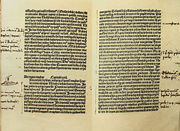
The main problem was that experts did not accept his estimate. The true circumference of the Earth is about 40,000 km (25,000 sm), a figure established by Eratosthenes in the second century BC, and the distance from the Canary Islands to Japan 19,600 km (12,200 sm). No ship that was readily available in the 15th century could carry enough food and fresh water for such a journey. Most European sailors and navigators concluded, likely correctly, that sailors undertaking a westward voyage from Europe to Asia non-stop would die of thirst or starvation long before reaching their destination. Spain, however, having completed an expensive war, was desperate for a competitive edge over other European countries in trade with the East Indies. Columbus promised such an advantage.
While Columbus' calculations underestimated the circumference of the Earth and the distance from the Canary Islands to Japan by the standards of his peers as well as in fact, almost all Europeans held the mistaken opinion that the aquatic expanse between Europe and Asia was uninterrupted. As the 16th century developed it was the route to America, rather than to Japan, that gave Spain a competitive edge in developing an overseas empire.
There was a further element of key importance in the plans of Columbus, a closely-held fact discovered by or otherwise learned by Columbus: the trade winds. A brisk wind from the east, commonly called an "easterly", propelled Santa Maria, La Nina, & La Pinta for 5 weeks from the Canaries. To return to Spain eastward against this prevailing wind would have required several months of an arduous sailing technique, called beating, during which food & drinkable water would have been utterly exhausted. Columbus returned home by following prevailing winds northeastward from the southern zone of the North Atlantic to the middle latitudes of the North Atlantic, where prevailing winds are eastward (westerly) to the coastlines of Western Europe, where the winds curve southward towards the Iberian Peninsula. In fact, Columbus was wrong about degrees of longitude to be traversed and wrong about distance per degree, but he was right about a more vital fact: how to use the North Atlantic's great circular wind pattern, clockwise in direction, to get home.
Some mean that his confidence in that land was within reach, was based on his travel in 1477 (1476-1477), which may have taken him to Baffin Island at 73 degrees north (in German). On this tour he could also get information from norse sailors and inuit kayakers trading on the long coast extending from north to south at about this longitude. (Pre Columbian turkey depicted (in German))
Funding campaign
In 1485, Columbus presented his plans to John II, King of Portugal. He proposed the king equip three sturdy ships and grant Columbus one year's time to sail out into the Atlantic, search for a western route to Orient, and then return home. Columbus also requested he be made "Great Admiral of the Ocean", created governor of any and all lands he discovered, and given one-tenth of all revenue from those lands discovered. The king submitted the proposal to his experts, who rejected it. It was their considered opinion that Columbus' proposed route of 2,400 miles (3,860 km) was, in fact, far too short.
In 1488 Columbus appealed to the court of Portugal once again, and once again John invited him to an audience. It too was to come to nothing, for not long afterwards came the arrival of Portugal's native son Bartholomeu Dias from a successful rounding of the southern tip of Africa. Portugal was no longer interested in trailblazing a western route to the East.
Columbus travelled from Portugal once more to both Genoa and Venice, but he received encouragement from neither. Previously he had his brother sound out Henry VII of England, to see if the English monarch might not be more amenable to Columbus' proposal. After much carefully considered hesitation Henry's invitation came, too late. Columbus had already committed himself to Spain.
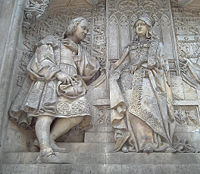
He had sought an audience from the monarchs Ferdinand II of Aragon and Isabella I of Castile, who had united the largest kingdoms of Spain by marrying, and were ruling together. On May 1, 1486, permission having been granted, Columbus laid his plans before Queen Isabella, who, in turn, referred it to a committee. After the passing of much time, these savants of Spain, like their counterparts in Portugal, reported back that Columbus had judged the distance to Asia much too short. They pronounced the idea impractical, and advised their Royal Highnesses to pass on the proposed venture.
However, to keep Columbus from taking his ideas elsewhere, and perhaps to keep their options open, the King and Queen of Spain gave him an annual annuity of 12,000 maravedis ($840) and in 1489 furnished him with a letter ordering all Spanish cities and towns to provide him food and lodging at no cost.
After continually lobbying at the Spanish court and two years of negotiations, he finally had success in 1492. Ferdinand and Isabella had just conquered Granada, the last Muslim stronghold on the Iberian peninsula, and they received Columbus in Córdoba, in the Alcázar castle. Isabella turned Columbus down on the advice of her confessor, and he was leaving town in despair, when Ferdinand intervened. Isabella then sent a royal guard to fetch him and Ferdinand later rightfully claimed credit for being "the principal cause why those islands were discovered". King Ferdinand is referred to as "losing his patience" in this issue, but this cannot be proven.
About half of the financing was to come from private Italian investors, whom Columbus had already lined up. Financially broke after the Granada campaign, the monarchs left it to the royal treasurer to shift funds among various royal accounts on behalf of the enterprise. Columbus was to be made "Admiral of the Seas" and would receive a portion of all profits. The terms were unusually generous, but as his own son later wrote, the monarchs did not really expect him to return.
According to the contract that Columbus made with King Ferdinand and Queen Isabella, if Columbus discovered any new islands or mainland, he would receive many high rewards. In terms of power, he would be given the rank of Admiral of the Ocean Sea (Atlantic Ocean) and appointed Viceroy and Governor of all the new lands. He had the right to nominate three persons, from whom the sovereigns would choose one, for any office in the new lands. He would be entitled to 10 percent of all the revenues from the new lands in perpetuity; this part was denied to him in the contract, although it was one of his demands. Finally, he would also have the option of buying one-eighth interest in any commercial venture with the new lands and receive one-eighth of the profits.
Columbus was later arrested in 1500 and supplanted from these posts. After his death, Columbus's sons, Diego and Fernando, took legal action to enforce their father's contract. Many of the smears against Columbus were initiated by the Spanish crown during these lengthy court cases, known as the pleitos colombinos. The family had some success in their first litigation, as a judgment of 1511 confirmed Diego's position as Viceroy, but reduced his powers. Diego resumed litigation in 1512, which lasted until 1536, and further disputes continued until 1790.
First voyage
On the evening of August 3, 1492, Columbus departed from Palos de la Frontera with three ships; one larger carrack, Santa María, nicknamed Gallega (the Gallician), and two smaller caravels, Pinta (the Painted) and Santa Clara, nicknamed Niña after her owner Juan Niño of Moguer. They were property of Juan de la Cosa and the Pinzón brothers ( Martin Alonzo and Vicente Yáñez), but the monarchs forced the Palos inhabitants to contribute to the expedition. Columbus first sailed to the Canary Islands, which were owned by Castile, where he restocked the provisions and made repairs, and on September 6, he started what turned out to be a five-week voyage across the ocean.
Land was sighted at 2 a.m. on October 12, 1492, by a sailor named Rodrigo de Triana (also known as Juan Rodríguez Bermejo) aboard Pinta. Columbus called the island (in what is now The Bahamas) San Salvador, although the natives called it Guanahani. Exactly which island in the Bahamas this corresponds to is an unresolved topic; prime candidates are Samana Cay, Plana Cays, or San Salvador Island (named San Salvador in 1925 in the belief that it was Columbus's San Salvador). The indigenous people he encountered, the Lucayan, Taíno or Arawak, were peaceful and friendly. From the October 12, 1492 entry in his journal he wrote of them, "Many of the men I have seen have scars on their bodies, and when I made signs to them to find out how this happened, they indicated that people from other nearby islands come to San Salvador to capture them; they defend themselves the best they can. I believe that people from the mainland come here to take them as slaves. They ought to make good and skilled servants, for they repeat very quickly whatever we say to them. I think they can very easily be made Christians, for they seem to have no religion. If it pleases our Lord, I will take six of them to Your Highnesses when I depart, in order that they may learn our language." Lacking modern weaponry and even metal-forged swords or pikes, he remarked upon their tactical vulnerability, writing, "I could conquer the whole of them with 50 men, and govern them as I pleased."
Columbus also explored the northeast coast of Cuba (landed on October 28) and the northern coast of Hispaniola, by December 5. Here, the Santa Maria ran aground on Christmas morning 1492 and had to be abandoned. He was received by the native cacique Guacanagari, who gave him permission to leave some of his men behind. Columbus left 39 men and founded the settlement of La Navidad in what is now present-day Haiti. Before returning to Spain, Columbus also kidnapped some ten to twenty-five natives and took them back with him. Only seven or eight of the native Indians arrived in Spain alive, but they made quite an impression on Seville.
Columbus headed for Spain, but another storm forced him into Lisbon. He anchored next to the King's harbour patrol ship on March 4, 1493 in Portugal. After spending more than one week in Portugal, he set sail for Spain. He reached Spain on March 15, 1493. Word of his finding new lands rapidly spread throughout Europe.
There is increasing modern scientific evidence that this voyage also brought syphilis back from the New World. Many of the crew members who served on this voyage later joined the army of King Charles VIII in his invasion of Italy in 1495 resulting in the spreading of the disease across Europe and as many at 5 million deaths.
Second voyage
Columbus left Cádiz, Spain, on September 24, 1493 to find new territories, with 17 ships carrying supplies, and about 1,200 men to colonize the region. On October 13, the ships left the Canary Islands as they had on the first voyage, following a more southerly course.
On November 3, 1493, Columbus sighted a rugged island that he named Dominica (Latin for Sunday); later that day, he landed at Marie-Galante, which he named Santa Maria la Galante. After sailing past Les Saintes (Los Santos, The Saints), he arrived at Guadeloupe ( Santa María de Guadalupe de Extremadura, after the image of the Virgin Mary venerated at the Spanish monastery of Villuercas, in Guadalupe, Spain), which he explored between November 4 and November 10, 1493.
The exact course of his voyage through the Lesser Antilles is debated, but it seems likely that he turned north, sighting and naming several islands, including Montserrat (for Santa Maria de Montserrate, after the Blessed Virgin of the Monastery of Montserrat, which is located on the Mountain of Montserrat, in Catalonia, Spain), Antigua (after a church in Seville, Spain, called Santa Maria la Antigua, meaning "Old St. Mary's"), Redonda (for Santa Maria la Redonda, Spanish for "round", owing to the island's shape), Nevis (derived from the Spanish, Nuestra Señora de las Nieves, meaning "Our Lady of the Snows", because Columbus thought the clouds over Nevis Peak made the island resemble a snow-capped mountain), Saint Kitts (for St. Christopher, patron of sailors and travelers), Sint Eustatius (for the early Roman martyr, St. Eustachius), Saba (also for St. Christopher?), Saint Martin (San Martin), and Saint Croix ( Santa Cruz, meaning " Holy Cross"). He also sighted the island chain of the Virgin Islands (and named them Islas de Santa Ursula y las Once Mil Virgenes, Saint Ursula and the 11,000 Virgins, a cumbersome name that was usually shortened, both on maps of the time and in common parlance, to Islas Virgenes), and he also named the islands of Virgin Gorda (the fat virgin), Tortola, and Peter Island (San Pedro).
He continued to the Greater Antilles, and landed at Puerto Rico (originally San Juan Bautista, in honour of Saint John the Baptist, a name that was later supplanted by Puerto Rico (English: Rich Port) while the capital retained the name, San Juan) on November 19, 1493. One of the first skirmishes between native Americans and Europeans since the time of the Vikings took place when Columbus's men rescued two boys who had just been castrated by their captors.
On November 22, Columbus returned to Hispaniola, where he intended to visit Fuerte de la Navidad (Christmas Fort), built during his first voyage, and located on the northern coast of Haiti; Fuerte de la Navidad was found in ruins, destroyed by the native Taino people, whereupon, Columbus moved more than 100 kilometers eastwards, establishing a new settlement, which he called La Isabela, likewise on the northern coast of Hispaniola, in the present-day Dominican Republic. However, La Isabela proved to be a poorly-chosen location, and the settlement was short-lived.
He left Hispaniola on April 24, 1494, arrived at Cuba (naming it Juana) on April 30. He explored the southern coast of Cuba, which he believed to be a peninsula rather than an island, and several nearby islands, including the Isle of Pines (Isla de las Pinas, later known as La Evangelista, The Evangelist). He reached Jamaica on May 5. He retraced his route to Hispaniola, arriving on August 20, before he finally returned to Spain.
During his second voyage, Columbus and his men instituted a policy in Hispaniola which has been referred to by numerous historians as genocide. The native Taino people of the island were systematically enslaved and murdered. Hundreds were rounded up and shipped to Europe to be sold; many died en route. For the rest of the population, Columbus demanded that all Taino under his control should bring the Spaniards gold. Those that didn't were to have their hands cut off. Since there was, in fact, little gold to be had, the Taino fled, and the Spaniards hunted them down and killed them. The Taino tried to mount a resistance, but the Spanish weaponry was superior, and European diseases ravaged their population. In despair, the Taino engaged in mass suicide, even killing their own children to save them from the Spaniards. Within two years, half of what may have been 250,000 Taino were dead. The remainder were taken as slaves and set to work on plantations, where the mortality rate was very high. By 1550, 60 years after Columbus landed, only a few hundred Taino were left on their island. In another hundred years, perhaps only a handful remained.
Third voyage
On May 30, 1498, Columbus left with six ships from Sanlúcar, Spain, for his third trip to the New World. He was accompanied by the young Bartolomé de Las Casas, who would later provide partial transcripts of Columbus' logs.
Columbus led the fleet to the Portuguese island of Porto Santo, his wife's native land. He then sailed to Madeira and spent some time there with the Portuguese captain João Gonçalves da Camara before sailing to the Canary Islands and Cape Verde. Columbus landed on the south coast of the island of Trinidad on July 31. From August 4 through August 12, he explored the Gulf of Paria which separates Trinidad from Venezuela. He explored the mainland of South America, including the Orinoco River. He also sailed to the islands of Chacachacare and Margarita Island and sighted and named Tobago (Bella Forma) and Grenada (Concepcion).
Columbus returned to Hispaniola on August 19 to find that many of the Spanish settlers of the new colony were discontented, having been misled by Columbus about the supposedly bountiful riches of the new world. An entry in his journal from September 1498 reads, "From here one might send, in the name of the Holy Trinity, as many slaves as could be sold..." Indeed, as a fierce supporter of slavery, Columbus ultimately refused to baptize the native people of Hispanolia, since Catholic law forbade the enslavement of Christians.
Columbus repeatedly had to deal with rebellious settlers and natives. He had some of his crew hanged for disobeying him. A number of returning settlers and sailors lobbied against Columbus at the Spanish court, accusing him and his brothers of gross mismanagement. On his return he was arrested for a period (see Governorship and arrest section below).
Fourth voyage
Columbus made a fourth voyage nominally in search of the Strait of Malacca to the Indian Ocean. Accompanied by his brother Bartolomeo and his 13-year-old son Fernando, he left Cádiz, Spain, on May 11, 1502, with the ships Capitana, Gallega, Vizcaína and Santiago de Palos. He sailed to Arzila on the Moroccan coast to rescue Portuguese soldiers whom he had heard were under siege by the Moors. On June 15, they landed at Carbet on the island of Martinique (Martinica). A hurricane was brewing, so he continued on, hoping to find shelter on Hispaniola. He arrived at Santo Domingo on June 29, but was denied port, and the new governor refused to listen to his storm prediction. Instead, while Columbus' ships sheltered at the mouth of the Rio Jaina, the first Spanish treasure fleet sailed into the hurricane. Columbus' ships survived with only minor damage, while twenty-nine of the thirty ships in the governor's fleet were lost to the July 1st storm. In addition to the ships, 500 lives (including that of the governor, Francisco de Bobadilla) and an immense cargo of gold were surrendered to the sea.
After a brief stop at Jamaica, Columbus sailed to Central America, arriving at Guanaja (Isla de Pinos) in the Bay Islands off the coast of Honduras on July 30. Here Bartolomeo found native merchants and a large canoe, which was described as "long as a galley" and was filled with cargo. On August 14, he landed on the American mainland at Puerto Castilla, near Trujillo, Honduras. He spent two months exploring the coasts of Honduras, Nicaragua, and Costa Rica, before arriving in Almirante Bay, Panama on October 16.
On December 5, 1502, Columbus and his crew found themselves in a storm unlike any they had ever experienced. In his journal Columbus writes,
For nine days I was as one lost, without hope of life. Eyes never beheld the sea so angry, so high, so covered with foam. The wind not only prevented our progress, but offered no opportunity to run behind any headland for shelter; hence we were forced to keep out in this bloody ocean, seething like a pot on a hot fire. Never did the sky look more terrible; for one whole day and night it blazed like a furnace, and the lightning broke with such violence that each time I wondered if it had carried off my spars and sails; the flashes came with such fury and frightfulness that we all thought that the ship would be blasted. All this time the water never ceased to fall from the sky; I do not say it rained, for it was like another deluge. The men were so worn out that they longed for death to end their dreadful suffering.
In Panama, Columbus learned from the natives of gold and a strait to another ocean. After much exploration, in January 1503 he established a garrison at the mouth of the Rio Belen. On April 6 one of the ships became stranded in the river. At the same time, the garrison was attacked, and the other ships were damaged. Columbus left for Hispaniola on April 16, heading north. On May 10 he sighted the Cayman Islands, naming them "Las Tortugas" after the numerous sea turtles there. His ships next sustained more damage in a storm off the coast of Cuba. Unable to travel farther, on June 25, 1503, they were beached in St. Ann's Bay, Jamaica.
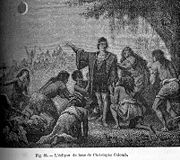
For a year Columbus and his men remained stranded on Jamaica. A Spaniard, Diego Mendez, and some natives paddled a canoe to get help from Hispaniola. That island's governor, Nicolás de Ovando y Cáceres, detested Columbus and obstructed all efforts to rescue him and his men. In the meantime Columbus, in a desperate effort to induce the natives to continue provisioning him and his hungry men, successfully intimidated the natives by correctly predicting a lunar eclipse for February 29, 1504, using the Ephemeris of the German astronomer Regiomontanus. Help finally arrived, no thanks to the governor, on June 29, 1504, and Columbus and his men arrived in Sanlúcar, Spain, on November 7.
Governorship and arrest
During Columbus' stint as governor and viceroy, he had been accused of governing tyrannically.. Columbus was physically and mentally exhausted; his body was wracked by arthritis and his eyes by ophthalmia. In October 1499, he sent two ships to Spain, asking the Court of Spain to appoint a royal commissioner to help him govern.
The Court appointed Francisco de Bobadilla, a member of the Order of Calatrava; however, his authority stretched far beyond what Columbus had requested. Bobadilla was given total control as governor from 1500 until his death in 1502. Arriving in Santo Domingo while Columbus was away, Bobadilla was immediately peppered with complaints about all three Columbus brothers: Christopher, Bartolomé, and Diego. Consuelo Varela, a Spanish historian, states: "Even those who loved him [Columbus] had to admit the atrocities that had taken place."
As a result of these testimonies and without being allowed a word in his own defense, Columbus upon his return, had manacles placed on his arms and chains on his feet and was cast into prison to await return to Spain. He was 53 years old.
On October 1, 1500, Columbus and his two brothers, likewise in chains, were sent back to Spain. Once in Cádiz, a grieving Columbus wrote to a friend at court:
It is now seventeen years since I came to serve these princes with the Enterprise of the Indies. They made me pass eight of them in discussion, and at the end rejected it as a thing of jest. Nevertheless I persisted therein... Over there I have placed under their sovereignty more land than there is in Africa and Europe, and more than 1,700 islands... In seven years I, by the divine will, made that conquest. At a time when I was entitled to expect rewards and retirement, I was incontinently arrested and sent home loaded with chains... The accusation was brought out of malice on the basis of charges made by civilians who had revolted and wished to take possession on the land.... I beg your graces, with the zeal of faithful Christians in whom their Highnesses have confidence, to read all my papers, and to consider how I, who came from so far to serve these princes... now at the end of my days have been despoiled of my honour and my property without cause, wherein is neither justice nor mercy.
According to testimony of 23 witnesses during his trial, Columbus regularly used barbaric acts of torture to govern Hispaniola.
Columbus and his brothers lingered in jail for six weeks before the busy King Ferdinand ordered their release. Not long thereafter, the king and queen summoned the Columbus brothers to their presence at the Alhambra palace in Granada. There the royal couple heard the brothers' pleas; restored their freedom and their wealth; and, after much persuasion, agreed to fund Columbus' fourth voyage. But the door was firmly shut on Christopher Columbus's role as governor. From that point forward, Nicolás de Ovando y Cáceres was to be the new governor of the West Indies.
Later life
While Columbus had always given the conversion of non-believers as one reason for his explorations, he grew increasingly religious in his later years. He claimed to hear divine voices, lobbied for a new crusade to capture Jerusalem, often wore Franciscan habit, and described his explorations to the "paradise" as part of God's plan which would soon result in the Last Judgment and the end of the world.
In his later years, Columbus demanded that the Spanish Crown give him 10 per cent of all profits made in the new lands, pursuant to earlier agreements. Because he had been relieved of his duties as governor, the crown did not feel bound by these contracts, and his demands were rejected. After his death his family later sued for part of the profits from trade with America in the pliegos colombinos.
On May 20, 1506, at about the age of 55, Columbus died in Valladolid, fairly wealthy from the gold his men had accumulated in Hispaniola. When he died he was still convinced that his journeys had been along the east coast of Asia. According to a study, published in February 2007, by Antonio Rodriguez Cuartero, Department of Internal Medicine of the University of Granada, he died of a heart attack caused by Reiter's Syndrome (also called reactive arthritis). According to his personal diaries and notes by contemporaries, the symptoms of this illness (burning pain during urination, pain and swelling of the knees, and conjunctivitis of the eyes) were clearly visible in his last three years.
His remains were first buried in Valladolid and then at the monastery of La Cartuja in Seville (southern Spain), by the will of his son Diego, who had been governor of Hispaniola. Then in 1542, his remains were transferred to Santo Domingo, in eastern Hispaniola. In 1795, the French took over Hispaniola, and his remains were moved to Havana, Cuba. After Cuba became independent following the Spanish-American War in 1898, his remains were moved back to the Cathedral of Seville in Spain, where they were placed on an elaborate catafalque. However, a lead box bearing an inscription identifying "Don Christopher Columbus" and containing fragments of bone and a bullet was discovered at Santo Domingo in 1877.
To lay to rest claims that the wrong relics were moved to Havana and that the remains of Columbus were left buried in the cathedral of Santo Domingo, DNA samples were taken in June 2003 (History Today August 2003). The results are not conclusive. Initial observations suggested that the bones did not appear to belong to somebody with the physique or age at death associated with Columbus. DNA extraction proved difficult; only a few limited fragments of mitochondrial DNA could be isolated. However, such as they are, these do appear to match corresponding DNA from Columbus's brother, giving support to the idea that the two had the same mother and that the body therefore may be that of Columbus. The authorities in Santo Domingo have not allowed the remains there to be exhumed, so it is unknown if any of those remains could be from Columbus's body. The location of the Dominican remains is in the "Columbus Lighthouse" or Faro A Colon which is in Santo Domingo, Dominican Republic.
Legacy
Sometimes thought of erroneously as the discoverer of the New World, Columbus was preceded by the various cultures and civilizations of the indigenous peoples of the Americas, as well as the Western world's Vikings. He is regarded more accurately as the person who brought the Americas into the forefront of Western attention. "Columbus' claim to fame isn't that he got there first," explains historian Martin Dugard, "it's that he stayed." Equally false is the notion that he was first to envision a rounded earth. This was known in ancient times, though largely forgotten in the Middle Ages. By Columbus's day, educated men were in agreement as to its spherical shape, even if many or most people believed otherwise. More contentious was the size of the earth, and whether it was possible in practical terms to cross such a vast body of water: the longest any ship (European or otherwise) had gone without making landfall did not much exceed 30 days when Columbus embarked on his first audacious voyage.
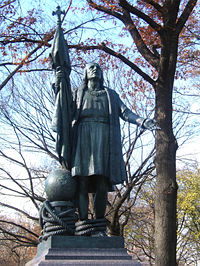
Amerigo Vespucci's travel journals, published 1502-4, convinced Martin Waldseemüller that the discovered place was not India, as Columbus always believed, but a new continent, and in 1507, a year after Columbus' death, Waldseemüller published a world map calling the new continent America from Vespucci's Latinized name "Americus".
Historically, the British had downplayed Columbus and emphasized the role of John Cabot as a pioneering explorer. But, for the emerging United States, Cabot made a poor national hero. Veneration of Columbus in America dates back to colonial times. America itself was sometimes referred to as Columbia. The use of Columbus as a founding figure of New World nations and the use of the word Columbia spread rapidly after the American Revolution. During the last two decades of the 18th century the name "Columbia" was given to the federal capital District of Columbia, South Carolina's new capital city, Columbia, South Carolina, the Columbia River, and numerous other places. Attempts to rename the United States "Columbia" failed, but Columbia became a female national personification of America, similar to the male Uncle Sam. Outside the United States the name was used in 1819 for the Republic of Colombia, a precursor of the modern nation of Colombia.
A candidate for sainthood in the Catholic Church in 1866, Celebration of Columbus' legacy perhaps reached a zenith in 1892 when the 400th anniversary of his first arrival in the Americas occurred. Monuments to Columbus like the Columbian Exposition in Chicago were erected throughout the United States and Latin America extolling him. Numerous cities, towns, counties, and streets have been named after him, including the capital cities of two U.S. states ( Columbus, Ohio and Columbia, South Carolina).
In 1909, descendants of Columbus undertook to dismantle the Columbus family chapel in Spain and move it to a site near State College, Pennsylvania, where it may now be visited by the public. At the museum associated with the chapel, there are a number of Columbus relics worthy of note, including the armchair which the "Admiral of the Ocean Sea" used at his chart table.
Culpability is sometimes placed on contemporary governments and their citizens for the hardship suffered by Native Americans during the time of Christopher Columbus. Columbus myths and celebrations are generally a positive affair, making less room for this concept in history books. Christopher Columbus was strongly criticised in a song by Jamaican artiste Burning Spear titled 'A Damn Blasted Liar.' The controversial song opened a strong opinionated debate across much of the Caribbean region on the effects that Christopher Columbus and his leadership had on the region's native peoples.
The Spanish colonization of the Americas, and the subsequent effects on the native peoples, were dramatized in the 1992 feature film 1492: Conquest of Paradise to commemorate the 500th anniversary of his landing in the Americas. *In 2003, Venezuelan President Hugo Chávez urged Native American Latin Americans to not celebrate the Columbus Day holiday. Chavez blamed Columbus for leading the way in the mass genocide of the Native Americans by the Spanish.
Physical appearance
Although an abundance of artwork involving Christopher Columbus exists, no authentic contemporary portrait has been found. There is a portrait painted by Alejo Fernández, between 1505 and 1536, titled Virgen de los Navegantes in the Royal Alcazar in Seville. At the 1893 World's Columbian Exposition, 71 alleged portraits of Columbus were displayed, most did not match contemporary descriptions. These writings describe him as having reddish hair, which turned to white early in his life, light colored eyes, as well as being a lighter skinned person with too much sun exposure turning his face red.
In keeping with descriptions of Columbus having had auburn hair or (later) white hair, textbooks use the Sebastiano del Piombo painting (which in its normal-sized resolution shows Columbus's hair as auburn) so often that it has become the iconic image of Columbus accepted by popular culture.
In popular culture
Colombus is a significant historical figure and has been depicted in fiction and in popular films and television.
In 1991, author Salman Rushdie published a fictional representation of Columbus in The New Yorker, "Christopher Columbus and Queen Isabella of Spain Consummate Their Relationship, Santa Fe, January, 1492," (The New Yorker, June 17, 1991, p. 32). In Pastwatch: The Redemption of Christopher Columbus (1996) science fiction novelist Orson Scott Card focuses on Columbus' life and activities, but the novel's action also deals with a group of scientists from the future who travel back to the 15th century with the goal of changing the pattern of European contact with the Americas. British author Stephen Baxter includes Columbus' quest for royal sponsorship as a crucial historical event in his 2007 science fiction novel Navigator ( ISBN 978-0-441-01559-7), the third entry in the author's Time's Tapestry Series.
Columbus has also been portrayed in cinema and television, including mini-series, films and cartoons. Most notably he was portrayed by Gérard Depardieu in 1992 film by Ridley Scott 1492: Conquest of Paradise. Scott presented Columbus as an idealist as opposed to the view that he was ruthless and responsible for the misfortune of Native Americans. As in many of Scott's movies, the character is presented as having some ideas that weren't current at his time.
Other more recent productions include TV mini-series Christopher Columbus (1985) with Gabriel Byrne as Colombus, Christopher Columbus: The Discovery, a 1992 biopic film by Alexander Salkind, Christopher Columbus, a 1949 film starring Fredric March as Columbus, and comedy Carry On Columbus (1992).
